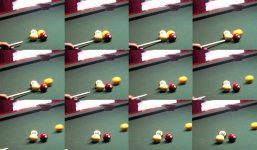It sounded like a double hit to me.
When I posted this video I really hadn't listened to it very carefully. The hit felt good, the balls reacted the way they should, so I didn't think there would be anyone calling it as a possible foul.
After reading a few posters who suspected it to be a foul, I took a careful listen. To my ears there is not the high-pitched click that usually accompanies the side of the shaft hitting the ball. There seems to be a trace of ball hop sound as the backspin lifted the OB up a few thousandths or so. That's what my table sounds like when such things happen, even at distances well outside of the foul range.
I was bored this afternoon, so I went through the hit sequence frame-by-frame and cropped each frame to show just the action. Each frame represents about 1/30th of a second.
In frame 2 you can see that the cue tip is just about to contact the CB. The CB hasn't moved yet.
In frames 3 and 4 you can see the extent of the follow through. Less than 1/2" of follow through, otherwise I would have run into the ball again as it sat there spinning for an instant. The two blocker balls would have been sent flying at that point as well.
In frame 5 you can see the CB still sitting there before the backspin took hold, but the cue had already been drawn back almost an inch, so it could not have been able to hit the ball. I estimate the elapsed time between contact and this point to be about 1/10th of a second or less.
In frame 6 you can see the draw finally taking hold, but the cue tip is now almost a ball diameter away.
In the remaining frames you can see that the CB is finally drawing back, but the cue is nowhere to be seen, having been withdrawn way back at this point.
If there is still any doubt at this point I'd be curious to hear what Mr. Jewett or Dr. Dave thinks about the shot. If I am missing something, I'd sure as hell like to know what it is, but to me, this is a fair hit with plenty of ball action for the very short stroke distance needed to make it without a double hit occurring.

